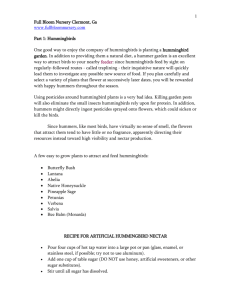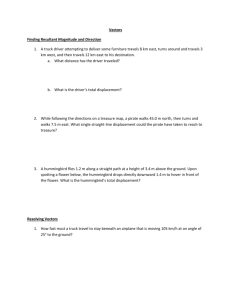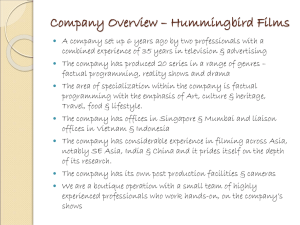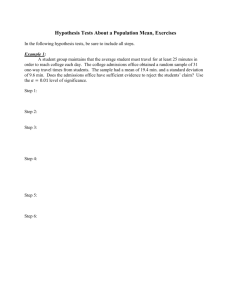Seminar Notes
advertisement
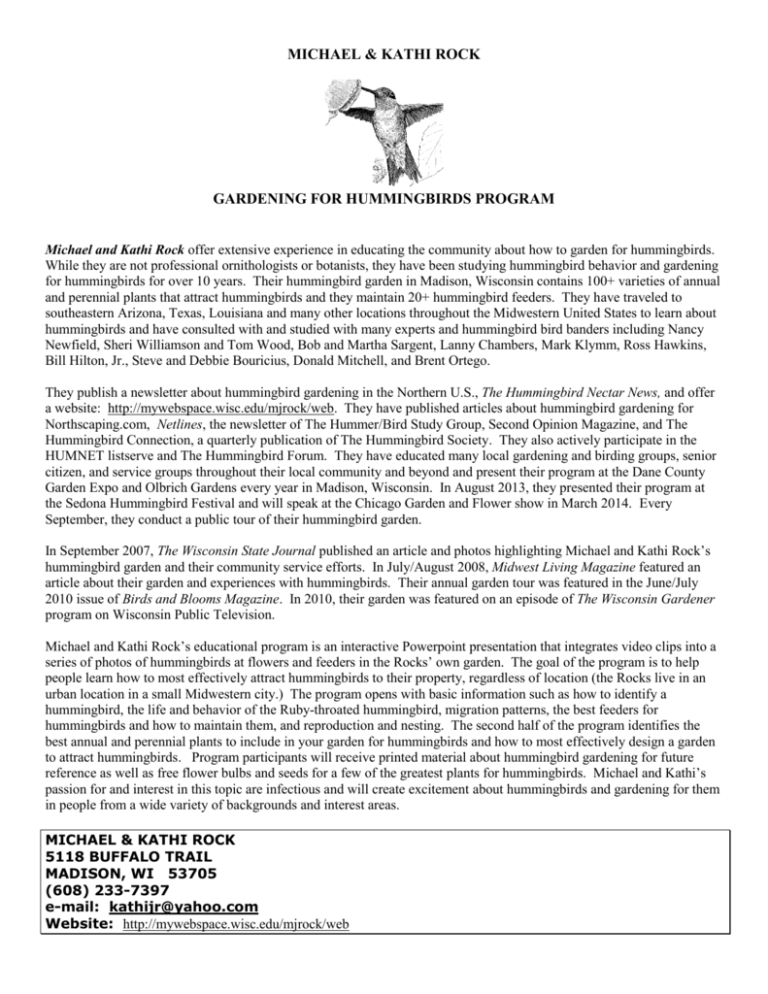
MICHAEL & KATHI ROCK GARDENING FOR HUMMINGBIRDS PROGRAM Michael and Kathi Rock offer extensive experience in educating the community about how to garden for hummingbirds. While they are not professional ornithologists or botanists, they have been studying hummingbird behavior and gardening for hummingbirds for over 10 years. Their hummingbird garden in Madison, Wisconsin contains 100+ varieties of annual and perennial plants that attract hummingbirds and they maintain 20+ hummingbird feeders. They have traveled to southeastern Arizona, Texas, Louisiana and many other locations throughout the Midwestern United States to learn about hummingbirds and have consulted with and studied with many experts and hummingbird bird banders including Nancy Newfield, Sheri Williamson and Tom Wood, Bob and Martha Sargent, Lanny Chambers, Mark Klymm, Ross Hawkins, Bill Hilton, Jr., Steve and Debbie Bouricius, Donald Mitchell, and Brent Ortego. They publish a newsletter about hummingbird gardening in the Northern U.S., The Hummingbird Nectar News, and offer a website: http://mywebspace.wisc.edu/mjrock/web. They have published articles about hummingbird gardening for Northscaping.com, Netlines, the newsletter of The Hummer/Bird Study Group, Second Opinion Magazine, and The Hummingbird Connection, a quarterly publication of The Hummingbird Society. They also actively participate in the HUMNET listserve and The Hummingbird Forum. They have educated many local gardening and birding groups, senior citizen, and service groups throughout their local community and beyond and present their program at the Dane County Garden Expo and Olbrich Gardens every year in Madison, Wisconsin. In August 2013, they presented their program at the Sedona Hummingbird Festival and will speak at the Chicago Garden and Flower show in March 2014. Every September, they conduct a public tour of their hummingbird garden. In September 2007, The Wisconsin State Journal published an article and photos highlighting Michael and Kathi Rock’s hummingbird garden and their community service efforts. In July/August 2008, Midwest Living Magazine featured an article about their garden and experiences with hummingbirds. Their annual garden tour was featured in the June/July 2010 issue of Birds and Blooms Magazine. In 2010, their garden was featured on an episode of The Wisconsin Gardener program on Wisconsin Public Television. Michael and Kathi Rock’s educational program is an interactive Powerpoint presentation that integrates video clips into a series of photos of hummingbirds at flowers and feeders in the Rocks’ own garden. The goal of the program is to help people learn how to most effectively attract hummingbirds to their property, regardless of location (the Rocks live in an urban location in a small Midwestern city.) The program opens with basic information such as how to identify a hummingbird, the life and behavior of the Ruby-throated hummingbird, migration patterns, the best feeders for hummingbirds and how to maintain them, and reproduction and nesting. The second half of the program identifies the best annual and perennial plants to include in your garden for hummingbirds and how to most effectively design a garden to attract hummingbirds. Program participants will receive printed material about hummingbird gardening for future reference as well as free flower bulbs and seeds for a few of the greatest plants for hummingbirds. Michael and Kathi’s passion for and interest in this topic are infectious and will create excitement about hummingbirds and gardening for them in people from a wide variety of backgrounds and interest areas. MICHAEL & KATHI ROCK 5118 BUFFALO TRAIL MADISON, WI 53705 (608) 233-7397 e-mail: kathijr@yahoo.com Website: http://mywebspace.wisc.edu/mjrock/web HUMMINGBIRD GARDENING FOR NORTHERN GARDENERS “The hummingbird is seen to stop thus some instants before a flower, and dart off like a gleam to another; it visits them all, plunging its little tongue into their bosom, caressing them with its wings, without ever settling, but at the same time ever quitting them.” W.C.L. Martin, General History of Hummingbirds, Circa 1840. KEY ELEMENTS OF A SUCCESSFUL HUMMINGBIRD GARDEN -A Garden Filled With Flowers Loved By Hummingbirds With Something in Bloom All Season Long! -Well-Maintained Feeders from April through October (with no instant nectar or red food coloring) -Cover, Perching & Preening Spots (trees & shrubs, shepherd’s hooks, tree snags) -Water Feature---water should be shallow and feature should include dripper or misting device -Hummingbird Beacons (red ribbons, metallic streamers, gazing ball, or any red object!) HUMMINGBIRD GARDENING TIPS Red or Orange Tubular Flowers with no fragrance Focus on Native Plants, Wildflowers & Single Flowers Plants with Many Small Blossoms Pointing Sideways or Down Plants With Long Bloom Period Plants that Bloom Profusely During August & September Mass Plantings of Flowers That are Hummingbird Favorites Height of Plants should be Tall, not Short (or utilize hanging baskets or large containers for shorter plants) Place Feeders & Flowers Where You Can See & Enjoy Them From Your Home! THE “DOZEN DAZZLER” HUMMINGBIRD PLANTS---The Best Plants for A Northern Hummingbird Garden (adapted from The Wildlife Gardener’s Guide to Hummingbirds & Songbird from the Tropics, Susan Day, Ron Rovansek and Jack Griggs, 2003, Harper Collins) RED TROPICAL SAGE, TEXAS SAGE, SCARLET SAGE (SALVIA COCCINEA) annual RED BEE BALM, OSWEGO TEA (MONARDA DIDYMA) perennial AUTUMN SAGE (SALVIA GREGGII) annual ANISE SAGE (SALVIA GUARANITICA) annual STANDING CYPRESS, SPANISH LARKSPUR (IMPOMPSIS RUBRA) biennial/perennial RED CARDINAL FLOWER (LOBELIA CARDINALIS) perennial SUNSET HYSSOP, LICORICE MINT (AGASTACHE RUPESTRIS, AGASTACHE CANNA) perennial MEXICAN CIGAR PLANT (CUPHEA “DAVID VERITY) annual INDIAN SHOT (CANNA INDICA) annual (lift bulbs after first frost & replant in spring) HONEYSUCKLE FUCHSIA, “GARTENMEISTER BONSTEDT” FUCHSIA (FUCHSIA TRIPHYLLA) annual CORAL HONEYSUCKLE, TRUMPET HONEYSUCKLE (LONICERA SEMPERVIRENS) perennial vine NICOTIANA MUTABILIS (FLOWERING TOBACCO) Reseeding Annual SALVIA ‘WENDY’S WISH annual OTHER GREAT PLANTS FOR HUMMINGBIRDS Annuals Cape Fuchsia (Phygelius x rectus) Lantana camara Salvia splendens Salvia amistad Salvia ‘Mulberry Jam’ Salvia Miniata Salvia praeclara (exserta) Stachytarpheta (Porterweed) Salvia involucrata (Rosebud Sage) Purple Majesty Sage Scarlet Betony, Scarlet Hedgenettle (Stachys coccinea) Spotted Jewelweel (Impatiens capensis)---reseeds vigorously, yellow Jewelweed will not attract hummingbirds Salvia darcyi & Salvia “Scarlet Spires” (hybrid of Salvias darcyi and greggii) Salvia “Hot Lips” & Salvia microphylla Shrimp Plant (Justicia brandegeana) Red Tropical Hibiscus (Hibiscus coccineus) Mexican Sunflower (Tithonia diversifolia or rotundifolia) Scarlet Monkeyflower (Mimulus cardinalis)---may be perennial, depending on winter severity & location Zinnia (tall, red varieties best) Perennials Red Hot Poker, Torch Lily (Knifophia uvaria)---select varieties that are 3-5 feet tall that bloom in late summer Penstemon (check for hardiness to zone 4---may be short-lived in the north, especially in clay soil and humid climates) Eastern Columbine (Aquilegia canadensis) Cat Mint ’Six Hills Giant’ (Nepeta giganteus) Canadian Milkvetch (Astragalus canadensis) Perennial Larkspur (Dephinium exaltatum) Royal Catchfly (Silene Regia) Indian Pink (Spigelia marilandica) Coral Bells (Heuchera sanguinea) Bleeding Heart (red or pink) (Dicentra spectabilis or eximia) Virginia Bluebells (Mertensia virginica) Fire Pink (Silene virginica) Hosta Pink or White Turtlehead (Chelone lyonii, glabra or obliqua) Shrubs (all are perennials in Zones 5 and 6---those hardy in Zone 4 are indicated with an “*”) Butterfly Bush, Summer Lilac (Buddleia davidii) Lilac* (Syringa vulgaris) Beauty Bush* (Kolkwitzia amabilis) Weigela florida*----red tubular flowers in June and sporadically throughout the summer. Crimson Flowered Currant, Gooseberry (Ribes Sanguineum)—may need protection in zones 4 and 5 Chokecherry* (Prunus virginiana) Snowberry* (Symphoricapos albus) Rose of Sharon (Hibiscus syriacus) Cardinal Autumn Olive* (Elaeagnus umbellata) Vines (often the forgotten plant in gardening---vines are a wonderful way to maximize the impact of a small garden!) Red Morning Glory (Ipomoea coccinea) ANNUAL (will reseed) Trumpet Creeper (Campsis radicans) Perennial Scarlet Runner Bean (Phaseolus coccineus) ANNUAL---protect from rabbits in early growth! Collect seeds at end of season and replant in spring Sweet Pea (Lathyrus) (perennial species only) Snapdragon Vine (Asarina antirrhinifolia) ANNUAL Firecracker Vine (Manietta cordifolia) ANNUAL Cardinal Climber (Ipomeoea x multifida) ANNUAL Trees Black Cherry (Prunus serotina) Flowering Dogwood (Cornus florida) Hackberry (Celtis occidentalis) Hawthorne (Crataegus) American Holly (Ilex opaca) Juniper---Eastern Red Cedar (Juniperus virginiana) Mulberry (Morus rubra) Oak (Quercus) Red Buckeye (Aesculus pavia) Serviceberry (Amelanchier) Cranberry Bush (Viburnum)----choose varieties with red berries. Horsechestnut (Aesculus hippocastanum x carnea)---red flowers in spring. PLEASE CHECK OUT OUR WEBSITE AT HTTP://MYWEBSPACE.WISC.EDU/MJROCK/WEB. You’ll see pictures of many of the plants listed above in our garden visited by real hummingbirds! “It is to be hoped that hummingbird gardeners will play a role in preserving the populations of hummingbirds throughout the New World. Along the way, they’re sure to be rewarded with plenty of hours of entertaining events in their yards to observe and lots of magical moments to remember. So why not get out your trowel and plant a sage or two? The hummingbirds are waiting!” (The Hummingbird Garden, Matthew Telulsky, The Harvard Common Press, 1990.) Michael & Kathi Rock 5118 Buffalo Trail Madison, WI 53705 608-233-7397 e-mail: kathijr@yahoo.com website: http://mywebspace.wisc.edu/mjrock/web rev. 02/2014 HUMMINGBIRD PLANTS SUITABLE FOR CONTAINERS, WINDOWBOXES & HANGING BASKETS Salvia coccinea (Texas Sage or Scarlet Sage): Annual---Red Flowers---Sun Salvia splendens (Red Hot Sally): Annual----Red Flowers----Sun Salvia guarantica (Anise Sage): Annual----Blue or Purple Flowers----Sun Salvia ‘Wendy’s Wish: Annual---Rose colored Flowers---Sun Salvia greggi (Autumn Sage): Annual---Red, Pink or Orange Flowers---Sun Salvia Blepharophylla (Eyelash Sage): Annual---Red Flowers----Sun Salvia Elegans (Honeydew Melon Sage only in the north—other form blooms too late): Annual--brilliant Red Flowers---Sun Agastache (Licorice Mint---‘Apricot Sprite’ hybrid is best): Annual or Perennial depending on hybrid--pink, red, orange or purple flowers----Sun (do not overwater or allow to become waterlogged!) Cuphea (Mexican Cigar Plant): Annual---Orange Flowers with yellow tips---Sun Fuchsia Triphylla (Honeysuckle Fuchsia): Annual---Orange or Red Flowers---Part sun (avoid late afternoon sun) Lantana camara: Annual---Pink/Yellow Flowers---Sun (do not overwater) Heuchera sanguinea: Perennial---Red Flowers---part sun to sun (blooms best in sun in the North) Salvia’Hot Lips’: Annual---white flowers with pink “lips”---Sun Phaseolus coccineus: Annual vine---Brilliant red Flowers---Sun Cardinal Climber (Impomeoea multifida): Annual vine----small red morning glory-type flowers----Sun Manietta inflata: Annual vine---- Red flowers---Sun Monarda (‘Petite Delight’ or ‘Fireball’---shorter cultivars): Perennial----Red Flowers---Part Sun to Sun Stachytarpheta (Compact Red Form): Annual---Red Flowers---Sun Penstemon barbatus, mexicale, or pinifolius: Perennial---Red or Pink Flowers---Sun (requires a dry, sandy soil) Abutilon pictum (Flowering Maple)---look for miniature size: Annual---Orange, Red or Yellow Flowers---Part Sun to Sun Stachys coccinea: Annual---Bright Red Flowers---Sun Ipomopsis rubra (Standing Cypress): Reseeding Annual---Bright Red Flowers---Sun THE MAGIC OF HUMMINGBIRDS Michael & Kathi Rock Hummingbirds are the smallest, fastest, and most fascinating birds of the New World. They are often referred to as “flying jewels” because of their iridescent and brilliantly colored feathers and fast-paced lifestyles. Hummingbirds are only seen in North and South America---about 338 species exist, with the most species being seen close to the equator. Sixteen of these species are seen in the United States----only one species, the fiery Ruby-throated hummingbird breeds and is commonly seen here in Wisconsin and east of the Great Plains. The Ruby-throated Hummingbird spends its summers in North America and then makes an amazing journey of as long as 1,000 miles (500 miles across the open water of the Gulf of Mexico alone!) to its wintering grounds in Mexico and South America. The fiery Rufous hummingbird has the longest migration route of any hummingbird, flying 3,000 miles from breeding areas in Alaska to wintering grounds in Mexico. Before beginning their long journey south, hummingbirds increase their weight by 50%. Hummingbirds typically arrive in Wisconsin around mid-April and depart in mid-October. Visit www.hummingbirds.net to learn more. A Ruby-throated hummingbird weighs 3 grams, or one-tenth the weight of a first-class letter. These birds are so light that you could put 10 of them in an envelope and mail the letter with a single stamp, but they’d return on their own power, flapping their wings 6080 beats per second. Of all birds, hummingbirds lay the smallest eggs. Each egg is less than ½ inch long---half the size of a jellybean! The female hummingbird constructs her minute nest out of spider webs and lichens and lays 2 eggs---she may breed twice in a typical season. The female hummingbird is larger than the male. The male hummingbird plays no part in the care of the babies. As soon as the brief mating act is completed, he is on to new conquests, leaving nesting and childcare to the female. After males have mated with as many females as possible, they begin migrating south again (this can be as early as July 4). Ruby-throated hummingbirds most often nest in trees, typically on a down sloping branch 15-20 feet from the ground. Finding a hummingbird nest is extremely difficult and you may have to follow the mother bird as she flies back to the nest to discover it. Never move or disturb a hummingbird nest, even after nesting is complete (sometimes female birds will return to the same nest year after year and it is illegal to tamper with nests of these protected birds.) These birds have ferocious appetites, eating 5-8 times per hour. They eat small insects and nectar from tubular, nectar-filled flowers (feeding on as many as 1,000 blossoms per day and can consume over 6,000 calories per day!) or sugar water feeders that humans hang in their yards. Hummingbirds consume half their weight in sugar each day. Their metabolisms are fantastic---if an average person had a metabolism comparable to that of a hummingbird, they would have to eat 285 pounds of hamburger every day to maintain their weight! The hummingbird’s heart beats 1,260 times per minute and a resting bird takes 250 breaths per minute. The hummingbird’s flight capabilities are beyond belief. These tiny dynamos can fly up to 45 miles per hour and they can fly forward, backward or even upside down briefly. The hummingbird’s flight muscles account for one quarter of its total weight (compared to 5% in humans.) They are the only birds that can hover in mid-air for extended periods of time (other birds may briefly hover, but only the hummingbird with its highly specialized wing structure can hover indefinitely). Hummingbirds are fiercely aggressive and territorial and will attack much larger birds, including jays, crows and even hawks. Interestingly, they don’t live or migrate in groups, preferring to be alone and independent (and they don’t migrate on the backs of geese as is commonly believed!) Their only contact with other hummingbirds occurs during mating and nesting. When defending territory, they make a squeaky, metallic sound called “chittering” and this is most distinctively heard during August and September when the birds are furiously feeding for their long journey south. Otherwise, Ruby-throated hummingbirds do not sing like many other songbirds. Unlike humans and other mammals, hummingbirds have no sense of smell and locate food through their fantastic eyesight (it is believed that they can spot a hummingbird feeder or patch of red flowers from up to a mile away!) They investigate mostly red or orange flowers with no fragrance for nectar and pick small insects out of the air and off leaves (and often return to the same places every year!) Hummingbirds bathe by flying through sprinklers or spray from waterfalls or may flutter in wet foliage or dip in a shallow puddle. Nesting hummingbirds will often establish their nests near moving water, but away from sources of food, as they instinctively know to draw the attention of predators away from their young. Hummingbirds can live as long as 12 years, but most live 3-5 years. Predators of hummingbirds include house cats, praying mantis, toads, and larger birds---nestlings or very young birds are always the most vulnerable to predators. There have also been accounts of hummingbirds being killed by bees at hummingbird feeders. This material is adapted from The Stokes Hummingbird Book, by Donald & Lillian Stokes, Little, Brown & Co., 1989. FEEDER MAINTENANCE & CLEANING (Courtesy of Master Hummingbird Bander, Lanny Chambers, www.hummingbirds.net) Here's the recipe for artificial nectar (syrup): Use one part ordinary white cane sugar to four parts water. It's not necessary to boil the water. The microorganisms that cause fermentation don't come from the water; they are transported to the feeder on hummingbird bills. Store unused syrup in the refrigerator for up to two weeks. This mixture approximates the average sucrose content (about 21%) of the flowers favored by North American hummingbirds, without being so sweet it attracts too many insects. Distilled water may be used instead of tapwater. However, some researchers are concerned that distilled water lacks minerals that hummingbirds need, and believe it would be prudent to add a pinch of sodium-free salt, which contain potassium chloride, to feeder solutions made with distilled or demineralized water. This should help bring the salt content of artificial nectar back in line with that of natural nectar and help prevent electrolyte deficiencies. Do not use table salt (sodium chloride). Adding salt is not necessary if well or tap water is used. Any syrup solution will spoil eventually, regardless of temperature, so strict maintenance is required (see below). For the sake of completeness: another view of syrup concentration appeared in the May 1993 article by Reed Hainsworth and Larry Wolf, both noted hummingbird researchers. However, it's not clear that the health of the birds was considered, or merely their preferences - like children, hummers may tend to eat more candy than is good for them - and there is still a suspicion that high sugar concentrations can cause liver damage in hummingbirds. When I wrote Dr. Hainsworth asking for a reference to a more rigorously-scientific treatment of his data (i.e., a published paper), his reply dodged the question. Without reflection upon anyone's reputation, I stand by the opinion of the majority of hummingbird researchers, that a 1:4 mixture has been shown to do no harm, and any other formula must remain suspect. There are some specialized protein-added hummingbird food mixtures (e.g., Nektar Plus) that are useful in laboratory or rehabilitation settings, where no natural food is available, or possibly in emergency winter situations when hummingbirds will die without it. But realize that these mixtures are especially vulnerable to spoiling and in an ordinary feeder setting during warm weather would need to be changed every few hours. Feeder Maintenance Hanging a hummingbird feeder means assuming a certain amount of responsibility for the wellbeing of a fragile and trusting animal. If you are not prepared to follow the rigorous maintenance routine outlined below, perhaps you should consider planting a hummingbird garden, instead. Cleaning Experts tell me that hummingbirds will starve rather than consume spoiled feeder syrup, so a dirty feeder isn't likely to cause harm. But it may cost you the pleasure of their company if they abandon your yard for more reliable food sources elsewhere. Every filling, flush the feeder with hot tap water; a bottle brush can be very helpful. Do not use soap - hummers apparently don't like the taste, but bleach will remove it if you have this problem. Visually inspect the entire feeder for black mold; a bleach soak (see the next paragraph) is the best way to remove mold. Discard any unconsumed sugar water. If the birds are not emptying your feeder between cleanings, it's unnecessary and wasteful to fill it completely. If the sugar solution in your feeder turns cloudy, it's spoiled and needs to be replaced. This can happen in as little as two days. At least once a month, clean the feeder thoroughly with a solution of 1/4 cup bleach to one gallon of water. Soak the feeder in this solution for one hour, then clean with a bottle brush. Rinse well with running water and refill. Any remaining traces of bleach will be neutralized by reacting with the fresh syrup, and there's no need to air dry before refilling. Bleach is both safe and very effective. These is evidence that bleach accelerates leaching of BPA (a chemical known to cause genetic damage in mammals) from polycarbonate plastic. No one, as far as I know, has studied its effects on birds. If you are concerned about BPA, use full-strength white vinegar instead of bleach. When to Take Down the Feeder Hummingbirds will not delay migration if a feeder is present; they are driven by forces more powerful than hunger. If you live in the southeastern U.S., leaving a feeder up might attract one of the western hummers that visit the region in small numbers every winter. The Pacific coast of the U.S. (and extreme southwestern Canada) has a population of non-migratory Anna's Hummingbirds; if a feeder is maintained over the winter, hummers will visit it year-round. Some other locations near the Mexican border also have winter populations of several hummingbird species. See the About Hummingbirds section for more information. Ants They will find your feeder, unless you take precautions. Buy a dripless feeder; they really make a difference. Some feeder models feature a built-in ant moat that may be filled with water; don't use oil, since chickadees and other small birds like to drink from ant moats. You can make your own moat by running the hang wire through a hole in a spraycan top (use a dab of silicone sealer or hot glue to seal the hole). But the best defense against ants is to paint the inside bottom of an ant moat with Tanglefoot, a very sticky goo sold at nurseries, and install the moat open side down. This is extremely effective against ants, poses no risk of a bird getting stuck or contaminated, and is low maintenance, since it keeps the goo from being compromised by rain and dust. If you use Tanglefoot, or any other sticky or oily substance, you must be absolutely sure it cannot come into contact with a bird. I no longer recommend using duct tape or castor oil around suction cups or on hang wires. There's too much chance of a hummer brushing against it during feeder fights. Bees, Wasps, and Yellowjackets Bees and wasps are attracted to the color yellow. Since many hummingbird feeders have yellow plastic "flowers" or other parts, try removing such parts or painting them red before hanging your feeder in the spring - once bees learn where food is, they fly right back to the hive to tell all their friends, so avoiding their attention up front works best. You can buy a feeder with bee guards. However, those tend to be the drippiest feeders available (Perky-Pet "Four Flowers," etc.), and once they start dripping the bee guards are useless, since puddles form in the flowers outside of the bee guards, an easy meal for insects. Bees tell each other about good nectar sources using pheromones, so it may help to clean the feeder daily with vinegar. It may also help to rub a clove of garlic around the ports. I don't recommend using Pam or other oils or greases on hummingbird feeders. The only sure defense against bees and wasps is to absolutely deny them access to the syrup. In June 1997 I replaced my Perky-Pet 210-P with a HummZinger, which is inherently wasp-proof because the syrup level is too low for insects to reach, but easily in range of the shortest hummingbird tongue. I also bought a Perky-Pet Oasis feeder, a copy of the HummZinger with several design flaws, but just as effective against bees. Basin feeders are also available from Opus and other companies, and all are effective in denying food to bees and wasps. All are also easy to clean. If you choose not to try a new feeder and wasps persist, first try moving the feeder, even just a few feet; insects are not very smart, and will assume the food source is gone forever. They may never find it in its new location, while the hummers will barely notice that it was moved. If that doesn't work, take the feeder down for a day, or until you stop seeing wasps looking for it. You'll see hummers looking for it, too, but they won't give up nearly as soon as the wasps. Also, reducing the sugar concentration to 1 part sugar in 5 parts water will make it less attractive to insects, but probably won't make the hummingbirds lose interest.


